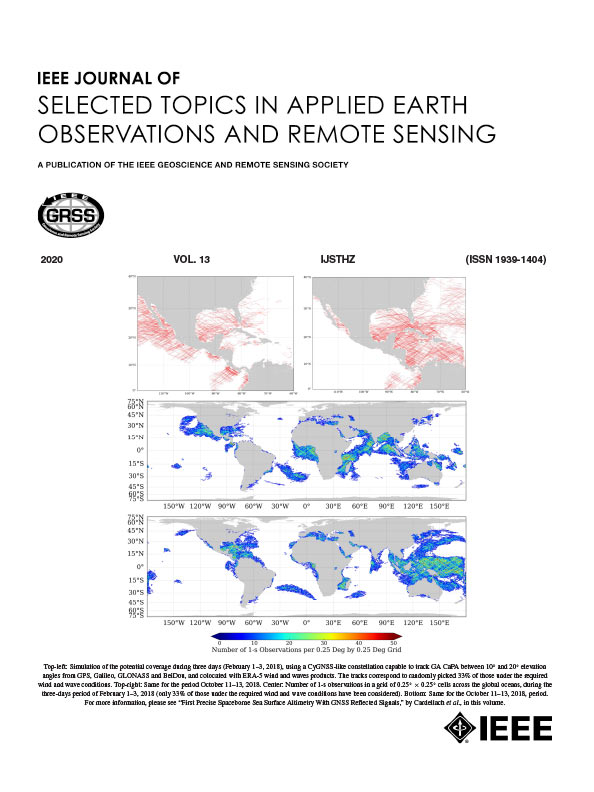A Machine-Learning-Based Ocean-Current Velocity Inversion Model Using OCN From Sentinel-1 Observations
IF 4.7
2区 地球科学
Q1 ENGINEERING, ELECTRICAL & ELECTRONIC
IEEE Journal of Selected Topics in Applied Earth Observations and Remote Sensing
Pub Date : 2025-03-26
DOI:10.1109/JSTARS.2025.3554229
引用次数: 0
Abstract
High-precision ocean-current velocity inversion is crucial for maritime activities. Synthetic aperture radar (SAR) has become a key data source for ocean-current velocity inversion. However, traditional methods, such as the Doppler centroid anomaly (DCA) and along-track interferometry methods, face challenges, such as low inversion accuracy, poor robustness, and limited data sources. This study developed OCN-CIM, a machine-learning-based model that directly derives the radial ocean-current velocity from Sentinel-1 observations. The model is trained using 186 scenes of Sentinel-1 Level 2 ocean data (OCN) collected between 14 July 2020 and 16 May 2024, in regions with strong currents along the East Coast of the United States. The ground truth is obtained from matched high-frequency radar data. Built on a fully connected neural network, the OCN-CIM features a custom loss function focused on high ocean-current velocities. The model achieved a mean absolute error (MAE) of 0.16 m/s, root-mean-square error (RMSE) of 0.20 m/s, and mean deviation (MD) of 0.005 m/s on the test dataset. When applying the OCN-CIM to ten independent cases, the average MAE, RMSE, and MD were 0.13 m/s, 0.16 m/s, and −0.03 m/s, compared with 0.26 m/s, 0.34 m/s, and 0.06 m/s for the traditional DCA method, demonstrating significant improvement in inversion accuracy. In addition, the OCN-CIM exhibits robustness, with reduced sensitivity to local wind and SAR data anomalies, and consistent results across various electromagnetic direction error-correction methods.基于机器学习的基于OCN的海流速度反演模型
高精度洋流速度反演对海上活动至关重要。合成孔径雷达(SAR)已成为洋流速度反演的关键数据源。然而,多普勒中心点异常(DCA)和沿轨干涉测量法等传统方法面临着反演精度低、鲁棒性差和数据源有限等挑战。本研究开发了 OCN-CIM,这是一个基于机器学习的模型,可直接从哨兵 1 号观测数据中推导出径向洋流速度。该模型是利用 2020 年 7 月 14 日至 2024 年 5 月 16 日期间收集的 186 个场景的哨兵-1 号 2 级海洋数据(OCN)进行训练的,这些场景位于美国东海岸洋流较强的区域。地面实况来自匹配的高频雷达数据。OCN-CIM 建立在全连接神经网络基础上,其特点是针对大洋流速度定制了损失函数。该模型在测试数据集上的平均绝对误差 (MAE) 为 0.16 米/秒,均方根误差 (RMSE) 为 0.20 米/秒,平均偏差 (MD) 为 0.005 米/秒。将 OCN-CIM 应用于 10 个独立案例时,平均 MAE、RMSE 和 MD 分别为 0.13 m/s、0.16 m/s 和 -0.03 m/s,而传统 DCA 方法的平均 MAE、RMSE 和 MD 分别为 0.26 m/s、0.34 m/s 和 0.06 m/s,反演精度显著提高。此外,OCN-CIM 还表现出稳健性,降低了对局部风和合成孔径雷达数据异常的敏感性,并在各种电磁方向误差校正方法中取得了一致的结果。
本文章由计算机程序翻译,如有差异,请以英文原文为准。
求助全文
约1分钟内获得全文
求助全文
来源期刊
CiteScore
9.30
自引率
10.90%
发文量
563
审稿时长
4.7 months
期刊介绍:
The IEEE Journal of Selected Topics in Applied Earth Observations and Remote Sensing addresses the growing field of applications in Earth observations and remote sensing, and also provides a venue for the rapidly expanding special issues that are being sponsored by the IEEE Geosciences and Remote Sensing Society. The journal draws upon the experience of the highly successful “IEEE Transactions on Geoscience and Remote Sensing” and provide a complementary medium for the wide range of topics in applied earth observations. The ‘Applications’ areas encompasses the societal benefit areas of the Global Earth Observations Systems of Systems (GEOSS) program. Through deliberations over two years, ministers from 50 countries agreed to identify nine areas where Earth observation could positively impact the quality of life and health of their respective countries. Some of these are areas not traditionally addressed in the IEEE context. These include biodiversity, health and climate. Yet it is the skill sets of IEEE members, in areas such as observations, communications, computers, signal processing, standards and ocean engineering, that form the technical underpinnings of GEOSS. Thus, the Journal attracts a broad range of interests that serves both present members in new ways and expands the IEEE visibility into new areas.

 求助内容:
求助内容: 应助结果提醒方式:
应助结果提醒方式:


